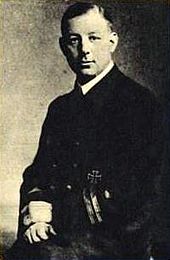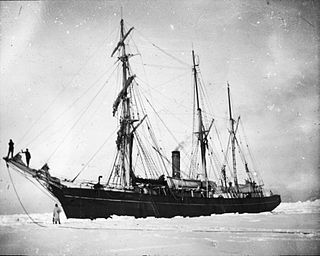
Nimrod was a wooden-hulled, three-masted sailing ship with auxiliary steam engine that was built in Scotland in 1867 as a whaler. She was the ship with which Ernest Shackleton made his Nimrod Expedition to Antarctica in 1908–09. After the expedition she returned to commercial service, and in 1919 she was wrecked in the North Sea with the loss of ten members of her crew.

Jun'yō Maru (順陽丸) was a cargo steamship that was built in Scotland in 1913, served a succession of British owners until 1927, and was then in Japanese ownership until a Royal Navy submarine sank her in 1944.
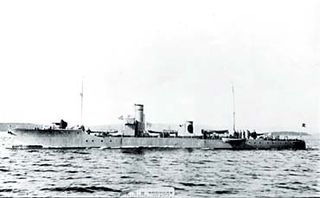
The last of the Trygg class of Royal Norwegian Navy torpedo boats was HNoMS Stegg. Her sister ships were Trygg and Snøgg. The Trygg class vessels were the only additions to the Norwegian fleet of torpedo boats between the First and the Second World Wars. At the outbreak of the Second World War the Trygg class was mobilised together with eight 2. class and six 1. class torpedo boats.

SS Minnedosa was one of a pair of transatlantic steam ocean liners that were built in the United Kingdom, launched in 1917 and operated by Canadian Pacific until 1935. Her sister ship was Melita.
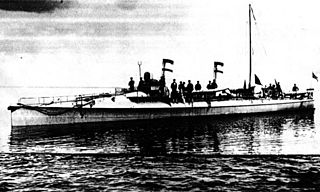
HNoMS Sæl was the penultimate vessel of the ten 1. class torpedo boats of the Royal Norwegian Navy. She was built at the Royal Norwegian Navy Shipyard in Horten in 1901, with yard number 85. She was to see close to 40 years service with the Royal Norwegian Navy, taking part in the preparations for war in connection with the dissolution the union with Sweden in 1905, enforcing Norwegian neutrality during the First World War and opposing the German invasion of Norway in 1940. She was lost in battle with Kriegsmarine vessels at Ånuglo in the Hardangerfjord on 18 April 1940.
HMS Hilary was a Booth Line passenger steamship that was built in Scotland in 1908 and operated scheduled services between Liverpool and Brazil until 1914. In the First World War she was an armed merchant cruiser (AMC) until a U-boat sank her in the Atlantic Ocean in 1917.

SS Henry was a Norwegian steam-powered cargo ship best known for being one of the two ships sunk in one of the most controversial incidents in Norway during the Second World War.

SS Irma was a 1,322-ton steamship built by the British shipyard Sir Raylton Dixon & Co. Ltd. in Middlesbrough in the north-east of England. She was delivered to the Norwegian passenger ship company Det Bergenske Dampskibsselskab of Bergen in 1905. Irma sailed for the company until she was attacked and sunk by two MTBs belonging to the Royal Norwegian Navy on 13 February 1944.
The SB Hibernia was a 75-ton spritsail Thames barge built in Greenhithe, Kent in England in 1906, and which was wrecked on the North Sea coast at East Runton during the night of 9/10 November 1937. Her crew of three were rescued by the Cromer lifeboat.

SS Polar Chief was a merchant steamship that was built in England in 1897 and scrapped in Scotland in 1952. In her 55-year career she had previously been called Montcalm, RFA Crenella, Crenella, Rey Alfonso, Anglo-Norse and Empire Chief. Early in the First World War she spent eight months pretending to be the battleship HMS Audacious.

HNoMS Storm was a 1.-class torpedo boat constructed in 1898. Storm served the Royal Norwegian Navy for almost 42 years, including neutrality protection duties during the First World War. She was lost in the 1940 Norwegian campaign of the Second World War. During the Norwegian Campaign, she was the only Norwegian warship that launched a torpedo against the invading Germans.
SS Hertford was a refrigerated cargo steamship that was launched in Germany in 1917, seized by the United Kingdom in 1920 as World War I reparations, and sunk by a U-boat in 1942 with the loss of four members of her crew.
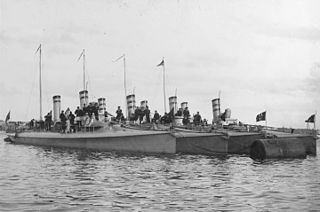
HNoMS Brand was a 1.-class torpedo boat constructed in 1898. She served the Royal Norwegian Navy for more than four decades, including neutrality protection duties during the First World War. Having once again been employed on neutrality protection duty at the outbreak of the Second World War, Brand was captured by the Germans during their invasion of Norway in April 1940.
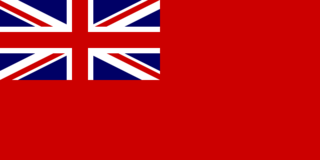
Merchant seamen crewed the ships of the British Merchant Navy which kept the United Kingdom supplied with raw materials, arms, ammunition, fuel, food and all of the necessities of a nation at war throughout World War II — literally enabling the country to defend itself. In doing this, they sustained a considerably greater casualty rate than almost every other branch of the armed services and suffered great hardship. Seamen were aged from fourteen through to their late seventies.
SS Glenartney was a cargo steamship that was launched in Scotland in 1911 and sunk by a U-boat in the English Channel in 1918.

SS City of Bradford was a British passenger and cargo steamship that was built in Yorkshire in 1903, renamed Donau in 1916, reverted to City of Bradford in 1919 and became Hanne in 1936.
SS Sagamore was a transatlantic cargo liner that was built in Ireland in 1892 for George Warren's White Diamond Steam Ship Company. In 1913 she was modified to carry passengers as well as cargo. In 1917 a German U-boat sank her, causing the death of 52 members of her crew.
SS Vespasian was a steel-hulled cargo steamship that was built in Sunderland in 1887 as Eastern Prince, renamed Vespasian in 1908 and scrapped in Newcastle upon Tyne in 1914. In 1908 the Parsons Marine Steam Turbine Company converted her to steam turbine propulsion. She is notable as the first ship in the World whose turbines drove her propeller by reduction gearing instead of direct drive.

SS Torrington was a British cargo steamship that was built in England in 1905, owned and registered in Wales, and sunk by a German U-boat in 1917. She was a turret deck ship: an unusual hull design that was developed by William Doxford & Sons of Sunderland in the 1890s.
SS Belgian Prince was a British cargo steamship that was launched in 1900 as Mohawk. She was renamed Hungarian Prince when she changed owners in 1912, and Belgian Prince after the United Kingdom declared war against Austria-Hungary and its allies in 1914.

